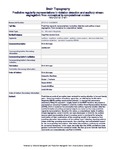Predictive regularity representations in violation detection and auditory stream segregation: from conceptual to computational models.
| dc.contributor.author | Schröger, E | en |
| dc.contributor.author | Bendixen, A | en |
| dc.contributor.author | Denham, SL | en |
| dc.contributor.author | Mill, RW | en |
| dc.contributor.author | Bőhm, TM | en |
| dc.contributor.author | Winkler, I | en |
| dc.date.accessioned | 2017-01-06T06:41:41Z | |
| dc.date.available | 2017-01-06T06:41:41Z | |
| dc.date.issued | 2014-07 | en |
| dc.identifier.uri | http://hdl.handle.net/10026.1/8210 | |
| dc.description.abstract |
Predictive accounts of perception have received increasing attention in the past 20 years. Detecting violations of auditory regularities, as reflected by the Mismatch Negativity (MMN) auditory event-related potential, is amongst the phenomena seamlessly fitting this approach. Largely based on the MMN literature, we propose a psychological conceptual framework called the Auditory Event Representation System (AERS), which is based on the assumption that auditory regularity violation detection and the formation of auditory perceptual objects are based on the same predictive regularity representations. Based on this notion, a computational model of auditory stream segregation, called CHAINS, has been developed. In CHAINS, the auditory sensory event representation of each incoming sound is considered for being the continuation of likely combinations of the preceding sounds in the sequence, thus providing alternative interpretations of the auditory input. Detecting repeating patterns allows predicting upcoming sound events, thus providing a test and potential support for the corresponding interpretation. Alternative interpretations continuously compete for perceptual dominance. In this paper, we briefly describe AERS and deduce some general constraints from this conceptual model. We then go on to illustrate how these constraints are computationally specified in CHAINS. | en |
| dc.format.extent | 565 - 577 | en |
| dc.language | eng | en |
| dc.language.iso | eng | en |
| dc.subject | Auditory Perception | en |
| dc.subject | Brain | en |
| dc.subject | Computer Simulation | en |
| dc.subject | Evoked Potentials, Auditory | en |
| dc.subject | Humans | en |
| dc.subject | Models, Neurological | en |
| dc.title | Predictive regularity representations in violation detection and auditory stream segregation: from conceptual to computational models. | en |
| dc.type | Journal Article | |
| plymouth.author-url | https://www.ncbi.nlm.nih.gov/pubmed/24271978 | en |
| plymouth.issue | 4 | en |
| plymouth.volume | 27 | en |
| plymouth.publication-status | Published | en |
| plymouth.journal | Brain Topogr | en |
| dc.identifier.doi | 10.1007/s10548-013-0334-6 | en |
| plymouth.organisational-group | /Plymouth | |
| plymouth.organisational-group | /Plymouth/REF 2021 Researchers by UoA | |
| plymouth.organisational-group | /Plymouth/REF 2021 Researchers by UoA/UoA04 Psychology, Psychiatry and Neuroscience | |
| plymouth.organisational-group | /Plymouth/Research Groups | |
| plymouth.organisational-group | /Plymouth/Research Groups/Centre for Brain, Cognition and Behaviour (CBCB) | |
| plymouth.organisational-group | /Plymouth/Research Groups/Centre for Brain, Cognition and Behaviour (CBCB)/Brain | |
| dc.publisher.place | United States | en |
| dcterms.dateAccepted | 2013-11-13 | en |
| dc.identifier.eissn | 1573-6792 | en |
| dc.rights.embargoperiod | Not known | en |
| rioxxterms.versionofrecord | 10.1007/s10548-013-0334-6 | en |
| rioxxterms.licenseref.uri | http://www.rioxx.net/licenses/all-rights-reserved | en |
| rioxxterms.licenseref.startdate | 2014-07 | en |
| rioxxterms.type | Journal Article/Review | en |


